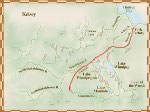 |
||||||||||||||||||||||||||||||
|
|
Henry Kelsey: On the Trail of Native Friends
Second Voyage
|
|||||||||||||||||||||||||||||
 |
| Kelsey travelled southwest with the help of the Native people and was the first European to see the Canadian Prairies Copyright/Source |
The next summer, on June 25, 1690, Kelsey left again, this time to find Native groups far away and start trading. He was also supposed to look for other possible economic resources such as mines and minerals.
Kelsey travelled southwest, always in the company of Cree and Assiniboine peoples. Kelsey was likely successful in his exploration because he was willing to follow the Native people's advice. He is credited with being the first European to see the Canadian Prairies.
 | ||
|
In 1691, Henry Kelsey described one of the ways the Plains Indians hunted buffalo: "When they see a great parcel of them together they surround them w[ith]men… they gather themselves into a smaller compass keeping beasts still in the middle and so shooting till they break out at some place or other and get away." This "surround" type of hunting was probably used most when bands were moving camp between seasons. A fur trader named A. Henry saw hunters use the fence method in 1776: "… At daylight, several of the more expert hunters were sent to decoy the animals into the pound. … Their faces were covered, and their gestures so closely resembled those of the animals themselves, that had I not been in the secret, I should have been as much deceived as the oxen…." The buffalo were then driven with loud cries into the fence enclosures. The Illustrated History of Canada. Edited by Craig Brown. Toronto: Lester Pub., ©1991, 1987, p. 48. |
||
|
| ||
 | ||
|
The buffalo provided meat, either eaten fresh or made into pemmican; hides for clothing, blankets, shelter (teepees) and shoes; sinews for bow-strings; bone for tools; the bladder and stomach for containers; and dried droppings for fuel. |
||
 |
| A buffalo rift Copyright/Source |
Buffalo Jump
Yet another method of hunting was to drive the buffalo over cliffs. The poor beasts would plunge to their death. Those that were crippled were also doomed. This hunting technique worked really well, but sometimes more buffalo were killed than could be used.
Prehistoric sites where buffalo were herded to their deaths over cliffs are found all over the prairies. The Gull Lake site in Saskatchewan has buffalo bones piled up 15 feet.
 | ||
|
Head-Smashed-In, near Lethbridge, Alberta was a cliff site used for 5000 years for hunting buffalo. It was so popular that archaeologists have uncovered 30 separate routes that lead to the cliffs. This site was shared by many different tribes. Later, as horses came to the Prairies, hunting became less risky but still dangerous. |
||
 
|